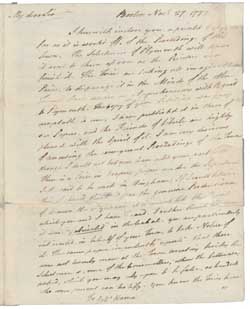Collections Online
Letter from Samuel Adams to James Warren, 27 November 1772
To order an image, navigate to the full
display and click "request this image"
on the blue toolbar.
-
Choose an alternate description of this item written for these projects:
- Main description
[ This description is from the project: Coming of the American Revolution ]
In this letter, Samuel Adams writes to James Warren, the newly elected elected chairman of Plymouth's Committee of Correspondence. Included with the letter is a copy of the recently published report from Boston's own Committee of Correspondence, the "Boston Pamphlet", outlining the rights of colonists and the recent Parliamentary acts infringing on those rights.
In Boston's Footsteps
As copies of the "Boston Pamphlet" begin to circulate in Massachusetts, residents in various towns petition their selectmen to consider the document and its arguments. In Plymouth, one hundred inhabitants sign a petition requesting a meeting. Other towns, however, are reluctant to act immediately in case the information concerning the payment of judicial salaries by the crown is incorrect. Eager to publicize any news of support, Samuel Adams shares the latest developments with James Warren, who has just been elected chairman of Plymouth's new "committee of communication".
Questions to Consider
1. According to Adams, which town has appointed a committee to consider the Boston Pamphlet? Which town is to have a meeting "next week"?
2. Why would Tories take "all imaginable Pains" to disparage the Boston Pamphlet?
3. Adams mentions a letter published in the newspaper under the signature I.H. Who does Adams suspect is the author of this letter?
4. Adams mentions another letter in the same newspaper that reports that only twenty men were present at the town meeting that approved of the Boston pamphlet. How does Adams respond to this statement?
Further Exploration
5. Adams mentions a letter published in the newspaper under the signature I.H. We know that the letter was published in the Massachusetts Gazette, on 26 November 1772. What resources could we use to discover the author's identity?

